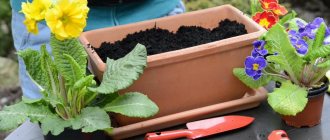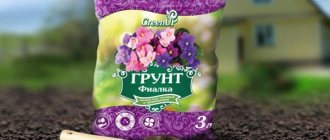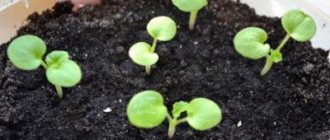Primrose or, as this plant is more correctly called, garden primrose is a very beautiful perennial plant that is the first to bloom in the spring. It has bright colors, and planting and caring for this primrose does not require much effort.
At the same time, gardeners can choose from hundreds of different varieties of primrose, thanks to which they can create the most unusual compositions in their suburban area.
Characteristic
The flower has a well-developed rhizome. In the zone of the root rosette there are leaf plates that are distinguished by their oblong shape. Some species are distinguished by the presence of so-called sessile leaves or petioles. There are also varieties of primrose that have wrinkled or leathery leaves that are greenish-gray in color.
There are no leaves on the elongated peduncles of primrose. Primrose buds can be single or part of common inflorescences. They also differ in their shape.
| Variety of primrose | Description and features |
| Primula vulgare | This is the most common type of plant, which is most often grown at home and looks great in a suburban area. The height of the plant does not exceed 10 cm. The flower has no stems. Multi-colored inflorescences can differ in different shades, ranging from white to deep black. The tricolor petals, which are collected in the shape of an umbrella, look especially beautiful. Primrose usually begins to bloom from February to April. This type of plant withstands night frosts well and is also suitable for growing on a loggia. When winter frosts occur, it is advisable to keep plants at a temperature not lower than -5°C. If the temperature drops below this indicator, then the plants must be brought indoors. |
| Hallera | This is a very unusual variety of primrose, which has almost disappeared. This medicinal plant is found at the foot of some mountains. This primrose grows up to 40 cm. It is distinguished by long leaves that are slightly retracted. The flowers resemble an umbrella with pointed tips. Primrose blooms from March to April. |
| Auricular | This primrose is often found in the Alps or the Balkans. The main feature of this plant is that it needs a large amount of calcium supplementation. In young primroses, the leaf plates are collected into a mundane rosette, which is located on short and wide petioles. Interestingly, the flowers of the auricular primrose smell the same as apricots, which is why they are of interest to gardeners. Plants begin to bloom in late May or early April. |
| Primrose small | This is another highland plant with very compact dimensions, which is suitable for acidic soil, rocky terrace or grassy slope. The primrose is distinguished by a short stem, the length of which reaches 1 cm. The flowers grow bell-shaped and purple. This variety of primrose is very resistant to frost, as it has a much better developed root system. |
| Mealy | This perennial primrose first appeared in Eurasia, as well as South America. The plants grow up to 30 cm high, the leaves have fibers, and the flowers have a pleasant pink hue. Flowering lasts from May to September. |
| High | This variety of primrose can grow up to 40 cm. It is distinguished by ovoid and slightly elongated leaves. Tall primrose flowers usually have two shades at once - with a yellow crown and an orange bud. |
| Retroscopic | This unusual primrose was bred in China. The height of the plant reaches 30 cm. Reverse primrose is distinguished by flowers of white, pinkish, red or a pleasant purple hue with green eyes. The leaves are also very beautiful. They are plugged into a socket. A stem grows from it. |
| Japanese | This unusual plant is distinguished by its decorative characteristics, as well as its unpretentiousness in the growing process. With proper care and watering, the height of the primrose can be 0.6 m. The flowers have a light yellow hue, and the length of the leaves can reach up to 20 cm. The plants reproduce independently, since after the flowering period spherical seed boxes are formed, which disperse the material for subsequent colors. This type of primrose is usually grown in slightly shaded areas. However, these flowers are also perfect for a well-lit place. The main thing is to ensure that the soil is moist and sufficiently acidic. Japanese primrose is quite sensitive to care. If she lacks something, she may die. It also does not tolerate frost very well. |
Perennial garden primrose (planting and caring for primrose will be discussed later in the article) goes well with low-growing and tall plants . Since it has bright colors and is one of the first to bloom, it becomes an indispensable element of the flower bed.
Transplanting clematis
Clematis tolerates transplantation very difficult. The roots of this plant are delicate and vulnerable; they take a long time to recover and adapt to the new planting site.
Important! In order for minimal damage to be caused to the plant during replanting, the technology should be strictly adhered to. Also, to move this plant to another area, you will have to cut off its long shoots. This will deprive you of the opportunity to admire the lush flowering of clematis in the year of planting.
This will deprive you of the opportunity to admire the lush flowering of clematis in the year of planting.
Also, to move this plant to another area, you will have to cut off its long shoots. This will deprive you of the opportunity to admire the lush flowering of clematis in the year of planting.
Abundant flowering of clematis
Causes
The need to move the vine to another place may arise in several cases:
- The size of the bush is too large and there is not enough area for further growth.
- The age of the plant requires its rejuvenation.
- There is a need for a new specimen and it was decided to obtain it by dividing the bush.
- Initially, the landing site was chosen incorrectly.
- There was a need to carry out construction or repair work directly at the site where the vine grew.
- Clematis is affected by the disease and for recovery it requires a change in its place of growth.
Transfer
Particular difficulties during transplantation may arise if the plant is already mature and its size is large. Extracting the root system with a large lump of earth will be problematic. Also, removing shoots from the support can be difficult.
When to replant clematis
To carry out this agrotechnical procedure, you can choose either autumn or spring. The timing for each region may vary depending on the climate.
When replanting in the spring, this work should begin only when the ground is well warmed up and the threat of frost has passed. The time of autumn planting should be determined so that the plant has time to get stronger before the onset of cold weather.
In some cases, it may be necessary to move the vine in the summer. This option is possible, but it is better to avoid it. If, nevertheless, transplanting clematis to another place in the summer is necessary, two important rules must be followed:
- Two to three days before transplanting, clematis should be well watered, which will provide its roots with moisture for the first time after moving.
- After removing the root system with a lump of earth, it must be wrapped in thick cloth. This will prevent moisture loss due to high temperatures and exposure to sunlight.
It is also worth considering that you will not be able to enjoy the flowering this year.
Important! There is even a risk that next year, due to the long adaptation period, the vine will not bloom
Preparation of planting material and propagation
Primrose can be planted using a variety of methods. As a rule, gardeners prefer sowing seeds. However, almost immediately after purchasing the seed, it needs to be planted. Primrose seeds lose their viability very quickly.
The same applies to those situations when the gardener independently collects seeds after the plants flower. Planting should be done immediately after collection.
For this, ordinary wooden boxes are usually used, which are placed in open soil. If the seeds were purchased in a store, it is recommended to plant them in the first days of February. To do this, the box must be filled with a nutrient substrate, which consists of grain, as well as leaf soil and sifted sand (proportions 2:1:1).
The seeds are distributed over the surface of the substrate, but are not buried into it. No more than 5 seeds can be placed per 1 cm2 of prepared nutrient substrate. After this, the box must be covered with polyethylene and placed in the freezer, where the temperature is maintained at 10°C. The seeds should remain in this state for 1 month.
This hardening procedure is necessary to ensure that young shoots do not die in the open ground immediately after planting in cold nights. After hardening, the boxes can be placed directly in a plastic bag on the window and make sure that they are protected from the morning sun.
As a rule, seeds germinate best at temperatures between 16 and 18°C. The first shoots do not appear immediately, so you need to be patient. Typically, the polyethylene is removed from the boxes after about 2 weeks. Until this point, it is only necessary to occasionally open the seed box and provide the plants with fresh air.
Perennial garden primrose, planting and caring for which does not cause difficulties, takes quite a long time to sprout when grown from seeds. Therefore, many gardeners prefer ready-made seedlings. It is best to purchase seedlings that already have 2-3 full leaves.
This is the optimal state of young flowers for picking into another box (it is better to move the plants to another container using tweezers). The soil in the new boxes must be moistened.
But it must be borne in mind that such young seedlings will be ready for the harsher conditions of open ground only a few years after the appearance of the first shoots. Therefore, you can immediately purchase two-year-old seedlings in the store.
Garden primrose can be propagated by seeds, by cuttings, by dividing bushes or by the leaf method. The latter method is rarely used, and the first one takes too much time.
What kind of soil does primrose like?
The culture likes to grow on loose and light soils that quickly absorb moisture. Also, if necessary, you need to add drainage, which is used as broken brick, expanded clay or crushed stone.
Important! Moisture cannot be allowed to linger in the ground for a long time, otherwise the plant will wither.
It is best to plant in loamy soils or black soil. You can also plant flowers in clay soils. If they are too heavy, then you can correct the situation by adding one bucket of manure, sand or sphagnum. Add the entire volume per 1 m².
Preparing the soil and planting site
When choosing a place where the primrose will be located, preference should be given to areas where there is no direct sunlight . But it is better not to plant primroses in the shade either. This should be a place where the sun's rays reach only in the evening, when they are not so aggressive as to cause leaf scorch.
In spring, the plant should receive plenty of light, and in summer, on the contrary, it should be in partial shade.
Based on this, the optimal solution would be to plant garden primrose under trees or deciduous shrubs. In summer, the flowers will be hidden from direct sunlight, and in early spring, when foliage has not yet formed on the trees, the primroses will receive a sufficient amount of light.
But, there are several nuances of growing primroses of different varieties, for example:
- In sunny places it is allowed to plant common primrose. But you need to make sure that the soil never dries out. It is better to choose fertile soil, with humus added earlier. The substrate should be heavy and contain humus. Also, common primrose grows well in loam.
- For powdery or Japanese primrose, it is recommended to prepare a peat substrate.
- The ear-shaped and pubescent primrose prefers soil that contains calcium.
Why replant primrose to a new place or in another pot?
For its active growth and abundant flowering, primrose takes nutrients and mineral elements from the soil. And the more luxuriantly a bush blooms in the garden, the faster the soil is depleted. Replanting is necessary in order to renew the soil and give the plant the necessary nutrition. Changing the soil promotes flower rejuvenation.
Replanting a plant is a sure way to rejuvenate and renew it
Replanting is necessary in order to prevent degradation of the flower, which blooms less readily and luxuriantly with age.
Additional Information! Primrose grows into a large, spreading bush within 4-5 years. The rosettes become crowded next to each other, which is why the plant stops blooming.
Landing algorithm
It is recommended to plant primrose in open ground at the first thaw in spring or early autumn, but only in the second year of the plant’s life. If you decide to plant primrose in the spring, then in this case it is recommended to carry out the procedure in the last days of May.
Planting in beds and flower beds can also be done in the summer, from mid-July to August. At this time, the primrose seedlings are transplanted to a permanent place. There should be a distance of 20-25 cm between plants. If before this the garden primrose grew in an apartment (for example, it was given as a gift in a pot), then in this case it can be transferred to the garden in March.
How well the plant takes root directly depends on the length of the roots. It is best to replant young plants. If you are transplanting from a pot into open ground, then at first you need to keep the young seedling in partial shade. Once it takes root and begins to develop, you can move it to a sunnier place.
If we are talking about seedlings prepared from seeds, then it is necessary to perform picking several times in a timely manner:
- The first picking is usually carried out 3 weeks after sowing. At this stage, it is necessary to pick young plants into a box, which is first filled with fresh soil.
- The second pick is performed a month later. The plants must be transferred again to fresh soil. In this case, in the new box the distance between plants should be about 45 cm.
- The third picking is performed when the young shoots begin to touch the leaves. This time, planting is done in pots with a diameter of 8 cm. As a rule, this procedure is performed approximately 6 weeks after sowing.
During the first week after the third transplant, the primrose must be watered three times a day, and the windows must be kept closed. After the plants have taken root a little and begin to grow intensively, you can gradually open the windows and ventilate them (first for 10-15 minutes, and then for several hours, 2-3 times a day).
Watering at this time is done when the soil in the pots begins to dry out. If you water young primroses too much, the roots will quickly begin to rot and the leaves will turn yellow.
In mid-July, the primrose should be transplanted for the last time into pots, the diameter of which should be up to 12 cm. At this stage, it is recommended to remove weaker plants. No more than 2 seedlings can be planted in one pot. It is recommended to prepare the soil by adding a small amount of compost. Also, the optimal soil acidity should be pH 5.6-6.
If the soil is neutral or alkaline, then the primrose leaves may also turn yellow and their edges will begin to dry out. This is explained by the fact that organic compounds are still distributed incorrectly in young plants.
Towards the end of September, the primrose can be transferred to a greenhouse in which the temperature is maintained within 10-12°C.
By October, nine-month-old seedlings should be well formed. Then the first inflorescences appear. It is at this stage that primrose seedlings are usually transferred to nurseries or planted in open ground if the seedlings were purchased or grown independently. Fully formed seedlings must be planted at a distance of 0.2-0.3 m.
What you need to know about caring for primrose
Lighting for primrose
The plant responds positively to bright sunlight, but placing the flower on the windowsill of a south-facing window requires great care. Burns may occur from scorching rays
Despite its love for the sun, primrose grows well in any room, even if the windows face north.
Temperature
To grow flowering primrose, it is recommended to maintain moderate coolness. With the onset of winter, the flower begins a dormant period, and the thermometer reading should not exceed +12 °C. In summer, flowering begins, at this time the most comfortable temperature for the flower is + 15 °C. You can create coolness by placing the plant between the window frames.
Watering and humidity indicators
Under natural conditions, primrose grows in soil with high humidity.
This is also important for home growing. When watering, it is important to stick to the golden mean so as not to flood the plant.
Popular articles Reproduction of fir by cuttings at home
In addition, with excess water, the root system often dies.
Spraying is recommended during the winter months and stops during the summer.
Soil for primrose
Primrose grows well in nutritious, loose soil. Such soil is sold in stores or made independently.
Ideal composition:
- peat;
- leaf soil;
- sand.
The first two components are mixed in equal proportions, and then a small amount of sand is added.
Primrose feeding
From the moment the buds appear, it is recommended to add a weak solution of microelements along with water every 10 days. Untimely application of fertilizing leads to accelerated leaf growth, but the primrose may not begin to bloom.
Primrose transplant
After flowering ends, you need to start replanting the primrose. This is an annual event: first, the stems that have wilted flowers and yellowed foliage are removed. If you are not sure about the nutritional value of the soil where the plant will be transplanted, then it is recommended to add an additive of humus, leaf soil and sand mixed in equal proportions. Pebbles or expanded clay are placed in the pot to act as drainage.
After purchasing a primrose, it also needs to be replanted. Most often, plants are sold in small pots with soil in which fertilizer capsules are added to ensure abundant flowering.
Choosing a suitable pot is quite simple - its size should be twice the size of the plant. The root system of the primrose must be carefully cleaned of the old soil, and only then can it be planted in new soil. Then abundant watering is necessary, but water should not get on the leaves.
In order for the primrose to grow well, it is recommended to trim all existing flowers. The pot should be placed in a cool room with bright lighting; to achieve high humidity, the greenhouse effect is used, the plant is covered with a plastic bag.
Primrose propagation methods
The breeding season occurs in autumn, after flowering has completed.
Primrose can be propagated by three methods:
- Primrose from seeds.
For sowing, you need a container with leaf soil mixed with sand. Primrose seed material is sprinkled with a little earth, and polyethylene or glass is used to create a greenhouse effect. Plants will begin to sprout in 14 days.
- Primrose cuttings.
From the primrose you need to separate the petiole, which has a leaf and a bud, and then place it in the ground. Sprinkle with a small amount of earth, cover with a glass jar and take to a cool room. Rooting lasts 90 days, then the primrose can be transplanted.
- Primrose division.
It is recommended to plant a young plant in the second year. Primrose is divided into shrubs and planted in individual containers. After a month, you can transplant it into a pot of suitable volume.
Diseases and pests of primrose
Excessive watering of primrose leads to the formation of gray rot. To get rid of it, you need to reduce the amount of watering, and use fungicides to treat the flower.
With a lack of humidity and too high a temperature, aphids and spider mites appear. Insecticides are used to control parasites.
In some cases, the leaves may turn yellow and the primrose drops its buds. This is a sign of improper care.
If primrose flowers quickly wither, you need to pay attention to the temperature regime. In the summer months it should not exceed +15 °C
Care
The perennial primrose requires not only proper planting, but also subsequent care. In the process of growing primrose, you need to follow simple recommendations for care, watering, fertilizing and other tips from experienced gardeners.
Spraying, watering
As a rule, most varieties of garden primrose tolerate drought conditions extremely poorly. In this regard, flowers need to be watered abundantly and regularly. It is important to check that the soil is moist. As soon as it dries, it is recommended to spray or water the plants.
In the conditions of central Russia, abundant watering once a week is sufficient, which includes 10 liters of water. Some people prefer to add 200 ml of water daily, but experienced gardeners advise watering more rarely, but more abundantly.
Much depends on the specific variety of primrose, since some species do not tolerate excess moisture very well. For example, this type includes powdery primrose, which is extremely sensitive to excess moisture, especially in winter. Therefore, this variety is usually planted in so-called permeable soil or in a raised bed.
Top dressing
Fertilizers need to be applied every 2 weeks. You can use standard formulations for flowering plants. Flower growers also recommend preparing your own solution, which consists of 2 g of ammonium nitrate, 1 g of 50 percent potassium sulfate and 2 g of superphosphate.
All these components must be diluted in 1 liter of water. The same mixture is used for seedlings that are in the greenhouse. It is important to ensure that the fertilizer does not contain calcium nitrate.
Transplanting an adult bush
Perennial garden primrose, planted and cared for in accordance with the recommendations of gardeners, is considered mature at 4-5 years. This is an excellent period to rejuvenate the plant. To do this, at the end of the summer season or before the 2nd week of September, you need to perform a transplant.
Transplantation of an adult perennial garden primrose bush is carried out for 4-5 years
The algorithm of actions is as follows:
- An overgrown bush of garden primrose must be watered generously and dug out along with a lump of earth.
- After this, you need to rinse the rhizome of the plant well in lukewarm water to remove the soil.
- At the next stage, you need to cut the roots into sections using a sharp knife. Each of them must have at least 1 resume point. The areas of the resulting cuts must be treated with ash.
- Immediately after treatment, the divided bushes need to be planted in a new place.
- All that remains is to water the primrose well again.
If the rhizome of the plant is too weak or there is only 1 rosette on it, then it is better to use axillary shoots for propagation. To do this, it is enough to separate a healthy leaf, which contains a bud, a petiole and part of the stem.
The resulting planting material must be cut in half and placed in prepared soil. The cuttings obtained by this method must be transferred to a lighted place (but without direct sunlight). When the stems grow from the buds and at least 3 young leaves appear, the shoots can be planted.
Trimming
Primrose leaves are pruned in early spring, as soon as the first snow has melted. In autumn, these measures are not carried out, since foliage is the main source of nutrition for the weakened root system, which will need additional strength in winter. In addition, dried leaves provide additional insulation and a protective layer against frost.
During the flowering process, it is necessary to ensure that faded buds are promptly removed. If left, they will also take nutrients from the plant.
Description of perennial primrose
Description of primrose bushes:
- plant height - 30 cm;
- leaves are oval, oblong, lanceolate;
- the bulb is large, up to 5 cm in length and 2 cm in width;
- the surface of the leaf plate is glossy, with a waxy coating.
A leaf rosette appears above the surface of the ground. It contains petiolate leaves. They are characterized by an oblong or ovoid shape. A peduncle up to 5 cm long grows from the central part of the rosette. A small umbrella forms at the top. Some varieties may appear to have single flowers with stems no larger than 7 cm.
Did you know? In Scandinavian countries, they believe that primrose flowers are the keys of the goddess Freya, who opens spring with them.
The corollas look beautiful and consist of five oval petals.
The edges can be pointed or rounded. The base is represented by a narrow long tube, and the edges are slightly bent. The colors of primrose can be different (variegated or plain). The colors of the inflorescences are different, depending on the variety.
They come in white, purple, lilac or pink. In the Leningrad region, varieties are most often grown that have an umbrella structure of inflorescences. This is due to the fact that they are more frost tolerant.
Video: Perennial primroses
What is the name of the primrose inflorescence?
The name primrose comes from the Latin word primus. It is translated as “first”. This can be explained by the fact that most varieties of primrose bloom early, before the snow begins to melt. If you plant a spring plant on a rocky hill, the composition will be called a rock garden. This will be appropriate because the culture comes from the European mountains.
Did you know? In Germany, primrose is considered a symbol of marriage. The first girl to find a flower during the Easter holidays will get married that year.
When does primrose bloom?
Primrose flowering depends on many factors. The most basic is the air temperature from +2°C. The first flowers will appear in early March. Primrose blooms early because it is highly resistant to frost. Plants can withstand cold temperatures down to -38°C.
Possible diseases and pests and ways to get rid of them
The most harmless pests that can harm garden primrose are snails and aphids. As a rule, they appear if the climate is too humid or if the primrose plantings are too thick. There are several methods to get rid of snails.
For example, some use a special granular preparation called Groza. It would also be a good idea to place spruce needles around the plants. Slugs and snails do not like to move on rough or scratchy surfaces.
However, it is first very important to remove them mechanically, that is, you will need to collect all the snails in a container and remove them as far as possible from the plant or burn them.
In order to get rid of aphids, it is necessary to wash all primrose leaves with a weak soap solution, in which any dishwashing detergent is added. If the insect colonies are already too large, then an insecticide will be required. For example, the drug Biotlin or Iskra is highly effective.
Primrose may also suffer from powdery mildew. That is a fungal type disease that first damages the lower leaves, and then rises higher and destroys the entire plant. At the first stage of development of powdery mildew, a light coating appears on the leaves, which is quite easy to wipe off. But then peculiar drops of liquid appear.
They are a product of the maturation of fungal pores. If they are fully formed, it will be very difficult to save the flower, since the damage to the foliage will be irreversible. Therefore, experienced gardeners recommend periodically inspecting the leaves of plants, especially from below.
If the first signs of the development of powdery mildew appear, then you need to treat with Topaz or Fitosporin. If the plants are severely affected, it is better to dig them up and burn them, as powdery mildew can quickly spread to other flowers.
Primrose also sometimes suffers from gray rot. In this case, unpleasant yellow spots appear on the shoots of the plant, around which a brown border forms. Similar signs can be seen when rust appears.
Only in this case the spots are distinguished by a uniform red-brown tint. Gradually, the spots merge and affect the plant with a cavity. Another sign of rust development is the appearance of tubercles on the bottom of the leaf in which spores collect.
Primrose may suffer from:
- Anthracnose. An unpleasant dark coating and small brown spots appear on the leaves, around which there is a yellow or brown border.
- Downy mildew. Transparent spots form on the outer part of the leaf, and whitish mold can be found on the inside of the leaf plate.
- Chlorosis. The leaves become colorless and the buds become deformed. The plant begins to grow much slower and blooms very little.
When these diseases (including rust and gray rot) appear, it is necessary to get rid of the infected parts of the plant, and treat the sections with crushed activated carbon. After this, you need to spray the plants with fungicide and pour a small amount into the soil.
Features of growing different types of primroses
If primroses suddenly disappear, they blame it on the harsh winter: they could not withstand the frost. In fact, if these perennials “leave the garden,” it is only because we do not know their characteristics, and each species has their own.
Popular articles Application, planting and care of western thuja Teddy
Primrose pink
For example, pink primrose grows in nature at the very edge of the Himalayan glaciers and loves coolness and moist soil. And therefore, the place for it in the garden should be appropriate - moist and shady.
Primula aurica
The homeland of the auricular primrose is alpine meadows, where it is dry, the soils are non-acidic and quite fertile. It succeeds only in limed, drained areas, where its thick, fleshy leaves never become soaked. It is this primrose, one of the few, that grows well in rockeries.
Primrose fine-toothed
Fine-toothed primrose, although hardy, can become damp after a warm autumn, so a mixture of compost and ash is added under it.
in the photo: fine-toothed primrose
Primrose siquim and Florinda
Primrose siquim and Florinda are water-drinkers. They are planted closer to the water, and the latter is also called swamp, since that is where it is best. And if there is a pond on the site with an adjacent territory where the soil is temporarily soaked, then this is the place for this primrose.
Japanese primrose and its hybrids
Primroses from East Asia (Japanese and its hybrids) can freeze out in winters with little snow, and it is better to cover them with a dry leaf, a layer of 10–15 cm.
Primrose Hallera
Primrose Haller has a different geography - the Carpathians and the Alps, growing on calcareous slopes. And, perhaps, this is the only species that tolerates bright sun well.
Primroses: spring, Voronova and Julia
But at the same time, there are also very unpretentious types of primroses: spring, common, Voronova, Julia. They do not require any special conditions and grow well and bloom profusely in partial shade on light soil with the addition of peat.
in the photo: spring primrose
General advice for keeping all primroses: plant them in dense clumps so that the ground is not visible (small species - Julia primroses, spring - after 10-15 cm, larger ones - after 30-40), as they do not like the soil to dry out. Care and transplantation of primroses are directly dependent on the structure of the bush. The rhizome of primroses grows obliquely upward. If they are not replanted for a long time and fertile soil is not added annually under the base of the bush, the primroses will end up on the soil surface and die.
Primroses need to be divided often. Species that grow quite quickly (Voronova, Julia, common, spring primroses) are divided every year. Those that do not behave too aggressively - once every 2-3 years. This operation should be started two weeks after the end of flowering. But if you notice that your primroses bloom twice, in spring and at the end of summer, that is, they have two phases of active growth, then divide them after the first flowering. Primulas with a poorly regenerating root system, for example fine-toothed, are divided in the spring before flowering or, in extreme cases, immediately after flowering.
Primroses respond well to feeding: the flowers become larger and brighter. Microfertilizers are applied every week from the beginning of the growing season in liquid form under the roots or “over the leaves”, in small doses (2–3 times less than for other perennials).
Peculiarities
Perennial garden primrose (planting and care must be done at the right time) looks great in any area. Since the plant is perennial, this allows you to create flowerbed designs that will delight you for many years. Primrose lends itself well to transplantation and propagation. There are many varieties of the flower.
But it is worth highlighting some of the problems that gardeners face when growing primrose:
- If the primrose does not have enough water or is exposed to scorching rays of the sun, it quickly begins to fade.
- When using cold water for irrigation, there is a risk of damaging the root system. If the roots begin to rot, it will be very difficult to notice immediately. There is a risk that the plant will die.
- If the primrose does not have enough fertilizer, the flowers become small and there are much fewer buds.
- An adult plant must not only be replanted, but also the bush must be divided, which takes quite a lot of time.
However, most of these disadvantages of perennial garden primrose are characteristic of many other flowers. Of course, primrose has more advantages than disadvantages. If you plant correctly and do not forget about caring for the plant, it will not cause any trouble.
Transfer
The optimal way to transplant primrose is transshipment.
When replanting a plant, you cannot bury the rosette into the ground - it must be on the surface. In the year when replanting is not carried out, it is recommended to update the top layer of soil (about 1.5 cm).
Primrose feels better in a clay flower pot. It is permeable to air, unlike plastic, the root system will breathe in it. It is better that the new pot has several drainage holes to drain excess water.
A drainage layer about 2 cm thick is placed on the bottom of the pot. 1-2 cm of fresh soil is poured on top so that the roots of the transplanted plant do not come into contact with the drainage fragments.
The plant is carefully removed from the old pot. If transplantation is necessary, its roots are tightly entwined with an earthen ball. The flower along with the soil is moved to the center of the new pot. There are empty spaces on the sides of the earthen ball that need to be filled with fresh soil mixture.
Now you know everything about planting and caring for indoor primrose at home, as well as how to replant and propagate a flower.
Reproduction
Primroses are propagated by dividing the bush and by seeds.
It is recommended to plant primrose once every three to four years. Otherwise, the bushes thicken, the flowers become smaller, and flowering becomes less abundant and lush. It is best to transplant in early spring or immediately after flowering. If for some reason it was not possible to carry out work during these periods, do not despair. It is quite acceptable to carry out a transplant at any other time. The main thing is to finish everything before mid-August. Then, before the onset of persistent cold weather, the plant will have time to acquire a good root system and successfully overwinter.
Primrose in landscape design
Primroses are considered typical spring flowers. However, you can choose the types and varieties of primrose so that they will bloom and be attractive from early spring to mid-summer. Particularly popular are polyanthus primroses, aurate primroses, and serrated primroses.
Primroses polyanthus, auricata and serrated can be used as borders of flower beds and compositions. They look especially good alongside spring bulbs and other early flowering perennials.
The article was provided by the author, Irina Korovina, as part of cooperation with our website
Online store Fazenda plus
Preparing for winter
Many varieties of this crop do not need to be replanted in the winter. Plants only need to be properly prepared for wintering:
- at the end of autumn, put humus under the bushes to protect the root system from frost;
- if necessary, cover the flower beds with additional snow, which will create a powerful air cushion and effectively protect the perennials from freezing;
- if the climate is characterized by scanty snowfall, cover the primrose with spruce branches or hay.
It is important not to trim the leaves of flowers in the fall, since the foliage will serve as a natural protection for the primrose from wind and frost in winter.
There are also hybrid species that are less frost-resistant. Therefore, it is better to dig them up and put them indoors for winter storage.
Fertilizer and feeding of primrose
During the dormant period, when primrose does not bloom, there is no need to apply fertilizer. Feed the plants 2-3 times per season:
- In early spring - a mineral complex.
- Use organics in June.
- Apply ammonium nitrate in August.
In order for the crop to develop well, it needs to be fed several times a season.
The last feeding can be replaced with superphosphate and potassium. It is believed that they increase the winter hardiness of primroses. For 10 liters of water, take 20 g of superphosphate and 15 g of potassium. You can use these fertilizers during other feedings.











